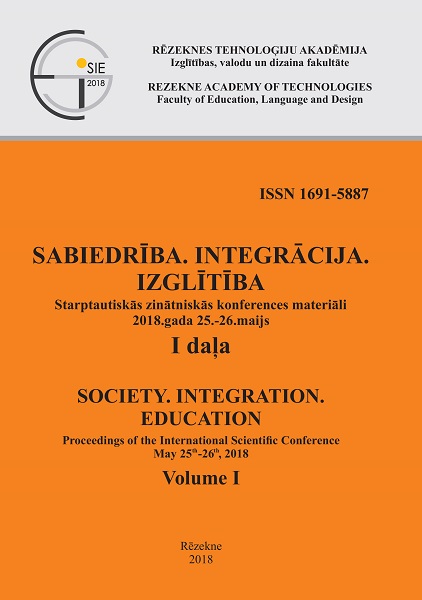UNIVERSITY LEVEL TEACHING STYLES WITH HIGH SCHOOL STUDENTS AND INTERNATIONAL TEACHING AND LEARNING
DOI:
https://doi.org/10.17770/sie2018vol1.3321Keywords:
hands on teaching style, international learning, international teaching, repetitive teaching style, risk analysisAbstract
The main aim of this paper is to render how university level courses are taught in high school. In fact, we will focus on what styles are used to teach university level courses and illustrate the international contrasts that happen quite frequently. In addition, we will analyse the details of teaching styles that were implemented in the American and the Latvian educational systems. Furthermore, we will discuss what specific teaching styles and innovations work successfully, and what teaching styles and innovations had difficulties and need improvements. In particular, implementing the hands-on teaching and learning styles and repetitive type teaching and learning styles. Moreover, we will also discuss the risk involved with introducing and transforming university level courses and teaching styles with high school students and how to manage these risks.
References
Bielaczyk, K., Collins, A., Joseph, D. (2004). Design research: Theoretical and methodological issues. Journal of the Learning Sciences, 13(1), 15-42.
Bourgeois L. (1980). Strategy and Environment: A Conceptual Integration. Academy of Management Review, 5.
Brent, R., Felder, R.M. (1996). Navigating the bumpy road to student - centered instruction. College Teaching, 44(2), 43-47.
Briere, D.E., Macsuga Gage A.S., Simonsen B. (2012). Effective teaching practices that promote a positive class environment. Beyond Behavior, 22(1), 14-22.
Cook, L., Friend, M. (1995). Co-teaching: Guidelines for creating effective practices. Focus on Exceptional Children, 28(3), 1-17.
Fulwiler, T., Strauss, M. (1990). Writing to learn in large lecture classes. Journal of College Science Teaching, 19(2), 158-163.
Grasha, A.F., Yangarber-Hicks, N. (2000). Integrating teaching styles and learning styles with Instructional Technology. College Teaching, 8(1), 2-11.
Graziano, K.J., Navarrete, L.A. (2012). Co-teaching in a teacher education classroom: Collaboration, compromise and creativity. Issues in Teacher Education, 21(1), 109-124.
Hadavand, S. (2008). Ten effective commandments in evaluation of training programs. Monthly Management, 15, 133–134.
Hake, R.R. (1998). Interactive-Engagement vs. Traditional Methods: A six-thousand-student survey of mechanics test data for introductory physics courses. American Journal of Physics, 66, 64-74.
Huberman, M. (1983). The role of teacher education in the improvement of educational practice: A linkage model. European Journal of Teacher Education, 6(1), 17 – 29.
Iyer, G., Tversky, B., Zacks, J. (2001). Perceiving, remembering, and communicating structure in events. Journal of Experimental Psychology Gen., 130, 29-58.
Jerkins, J.M. (1991). Learning styles: Recognizing individuality. Schools in the Middle, 1(12), 3-6.
Khnyfr, H. (2005). The higher education system in the world with strategy. Journal of Cultural Management, 3(9), 10.
Lynch, D.J. (2008). Confronting challenges: Motivational beliefs and learning strategies in difficult college courses. College Student Journal, 42, 416-421.
Matthew, D.B. (1996). An investigation of learning styles and perceived academic achievement for high school students. Clearing House, 69(4), 249-255.
Murgulis, E. (2012). Music repetition detection acrss mulitple exposures. Music Perception, 29, 377-385.
Panagiota, K., Stavrakouli, K. M., Vasiliki, B. (2016). A new teaching method for teaching economics in secondary education. IOSR Journal of Research & Method in Education, 6(2): 86-93.
Radin, M., Riashschenko, V. (2017). Effective pedagogical management as a road to successful international teaching and learning. Forum Scientiae Oeconomia, 5(4), 71-84.
Radomska, J. (2014). Operational Risk associated with the Strategy Implementation. De Gruyter, 18(2), 31–43.
Rosenfeld, M., Rosenfeld, S. (2008). Developing effective teacher beliefs about learners: The role of sensitizing teachers to individual differences. Educational Psychology, 28(3), 245-272.
Shields, P.M. (2003). A pragmatic teaching philosophy. Journal of Public Affairs Education, 9(1), 7 – 12.
Shuell, T.J. (1986). Cognitive conception of learning. Review of Educational Research, 56, 411-436.
Smallbone, T., Quinton, S. (2010). Feeding forward: Using feedback to promote student reflection and learning – a teaching model. Journal of Innovations in Education and Teaching International, 47(1), 125 – 135.
Snyder, R.F. (2000). The relationship between learning styles/multiple intelligences and academic achivement of high school students. High School Journal, 83(2), 11-21.
Spendlove, M. (2007). Competencies for effective leadership in higher education. International Journal of Educational Management, 21(5), 407-417.
Tomlinson, C.A. (2005). Quality curriculum and instruction for highly able students. Theory Into Practice, 44(2), 160-166.
Vermunt, J.D. (1998). The regulation of constructive learning process. British Journal of Educational Psychology, 68, 149-171.
Yakovlev, Y., Yakovleva, N. (2014). Interactive teaching methods in contemporary higher education. Pacific Science Review, 16, 75-80.






